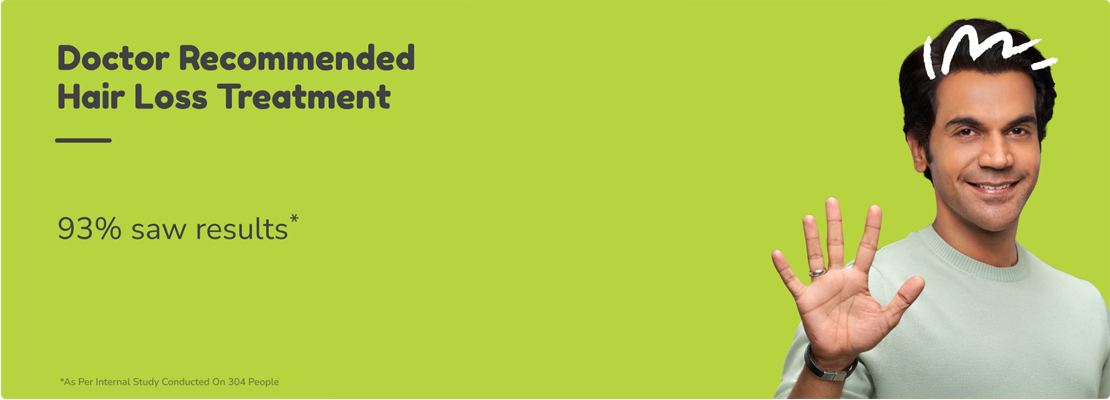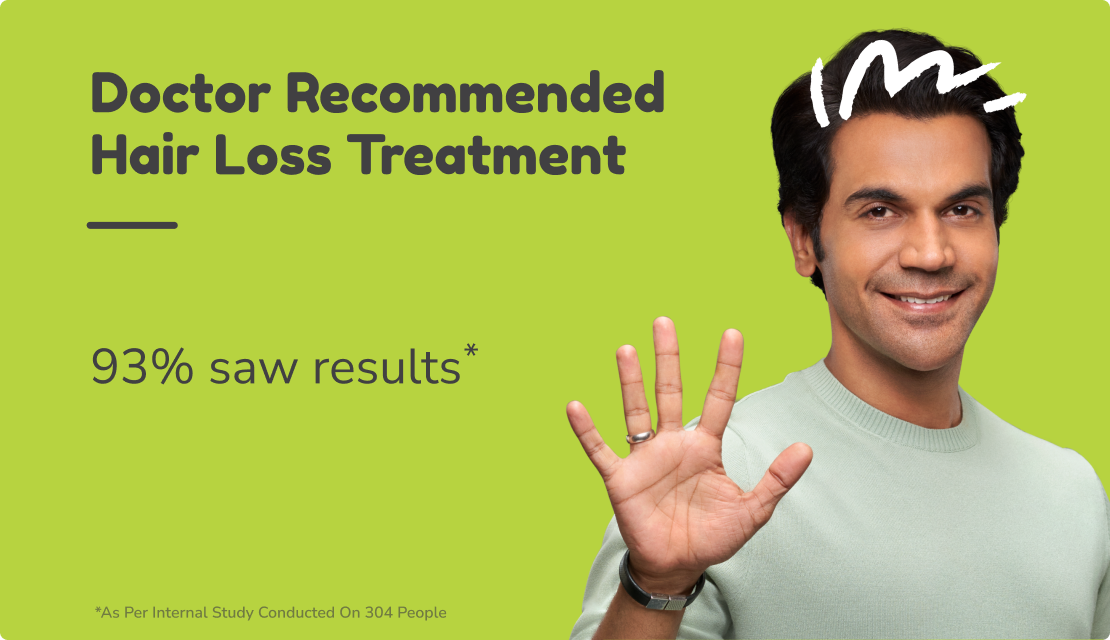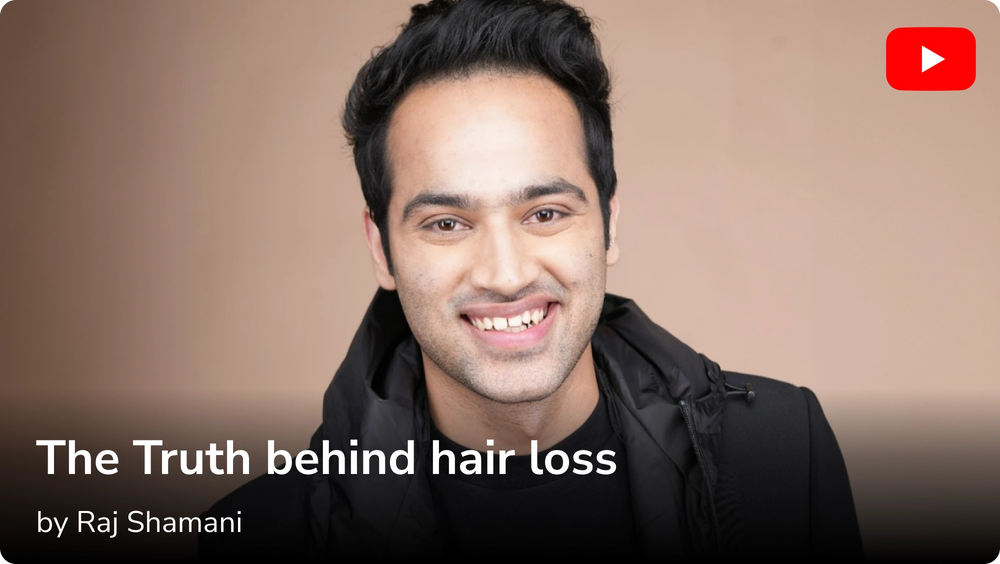Have you observed your forehead getting larger or more noticeable skin across the temples? Increased scalp visibility, also known as receding hairline is a sign of pattern hair loss. A receding hairline is an indication of early-stage male pattern hair loss. Let us understand what that means and what might be the cause.
While most people associate receding hairline with age, the signs can be seen early on, in fact in early 20's and 30's. One of the most promising takeaways from a study conducted by Traya Health is the growing consciousness of hair fall among individuals at an earlier stage. However, we also found out that despite increased awareness, many individuals are not taking timely action.
Pattern hair loss can be triggered by poor nutrition, high stress, poor sleep, health conditions (thyroid), and vitamin deficiency etc. an
There are many hair loss treatments which can help manage a receding hairline based on your current stage of hair loss. Therefore, having information about the root causes, reasons, stages, and type of your hair loss is very important when you look for a treatment. Traya provides a free hair test for the same and gives out all important, relevant information about your hair fall.
What is a Receding Hairline?
What does it mean when your hairline is receding? It means you are in the initial stage of pattern hair loss or androgenic alopecia. It happens as a result of dihydrotestosterone or DHT. DHT starts shrinking your hair follicles, this reduces the blood flow to your follicles. Because of this, your hair gets thinner, its growth phase becomes shorter. If not treated properly it results in your follicles getting sealed shut resulting in balding. Pattern hair loss is seen in both men and women. How hairline receding is a symptom associated with men.
Causes of Receding Hairline
There are multiple causes of a receding hairline and it is important to note that each individual's situation may differ, and a combination of factors can contribute to a receding hairline. If you are experiencing significant hair loss, it is best to consult a healthcare professional to determine the underlying cause and appropriate treatment.
Following are a few causes of receding hairline:
1. Male Pattern Baldness (Androgenetic Alopecia)
The most prevalent cause of receding hairlines in men, characterized by a genetic predisposition to sensitivity to dihydrotestosterone (DHT), a hormone that shrinks hair follicles.
2. Hormonal Imbalance:
Fluctuations in hormones, such as increased DHT levels in women or imbalances in thyroid hormones, can lead to hairline recession.
3. Age
As individuals age, the hair follicles may become less efficient in producing hair, resulting in a receding hairline.
4. Stress
Prolonged periods of stress can trigger a condition known as Telogen Effluvium, where hair enters a resting phase and subsequently falls out, potentially causing a receding hairline.
5. Poor Nutrition
Diets lacking essential nutrients, especially protein, iron, and vitamins (e.g., biotin, vitamin D), can weaken hair and contribute to hairline recession.
6. Hairstyles and Hair Treatments
Excessive pulling of hair due to tight hairstyles (like ponytails, braids) or aggressive chemical treatments can cause stress on hair follicles and lead to a receding hairline.
7. Medical Conditions
Certain medical conditions like alopecia areata (autoimmune disorder), scalp infections, or trichotillomania (hair pulling disorder) can result in hair loss and receding hairlines.
8. Medications
Some drugs, such as chemotherapy drugs, anticoagulants, and antidepressants, may have hair loss as a side effect, leading to a receding hairline.
9. Smoking
Smoking can affect blood circulation, including to the scalp, which may contribute to hair loss and a receding hairline.
10. Genetics
Family history plays a significant role in determining whether an individual is predisposed to receding hairline or male pattern baldness.
11. Environmental Factors
Exposure to pollutants, toxins, and UV radiation can damage hair follicles and lead to hairline recession.
12. Tight Hats or Helmets
Frequent use of tight-fitting headgear can put pressure on hair follicles, leading to hair loss and a receding hairline over time.
Signs You Have Receding Hairline
Recognizing the signs of a receding hairline early on can help you take appropriate measures to address the issue. Here are some common signs to look out for:
- Widening Forehead: One of the earliest signs is the gradual appearance of a higher forehead due to the hairline moving backward.
- Thinning Hair: Hair at the temples and crown area may start to become thinner, making the scalp more visible.
- "M" Shape: The hairline may form an "M" shape, with the two sides receding and leaving a central point in the middle.
- Receding Temples: The hairline may start to recede on both sides, creating a more pronounced "V" shape.
- Miniaturized Hair: The hair around the hairline and crown area may become finer and less pigmented compared to the rest of the hair.
- Excessive Shedding: You may notice an increased amount of hair fall when brushing, showering, or running your hands through your hair.
- Visible Scalp: As the hairline recedes, more scalp becomes visible, especially at the front and crown of the head.
- Hairline Looks Uneven: The hairline may become irregular, with certain areas receding more than others.
- Difficulty Styling: It becomes challenging to style your hair as the hairline moves back, making it harder to achieve certain hairstyles.
- Family History: If you have a family history of male pattern baldness or receding hairlines, you may be genetically predisposed to it.
Remember that some degree of hair loss is a natural part of the aging process for many individuals. However, if you notice significant hair loss, rapid hairline recession, or if you're concerned about it, it's essential to consult a healthcare professional or a dermatologist to determine the cause and explore potential treatment options. Early intervention can often lead to better outcomes.
Stages of Receding Hairline
The receding hairline typically progresses through various stages, which are commonly referred to as the Norwood scale or Hamilton-Norwood scale. These stages help categorize the different degrees of hairline recession in men. Keep in mind that not everyone will experience all these stages, and the rate of progression can vary from person to person. Here are the main stages:
Stage 1 : Hairline recedes
For men, at this stage, your hairline is going to recede and you will notice your forehead is larger than before. For women, they will notice the first signs of thinning around the hair partition. How do you know if there is thinning? Just wet your hair or oil it and see if your scalp is more visible than it was earlier.
Stage 2: Thinning around your vortex
At this stage, in men, you will see your hairline has gone back quite a bit. And you are thinning in the top portion of your scalp or around your vortex (the spiral portion at the back of your scalp). In women, the partition will be wider and your hair loss would have increased.
Stage 3: Hairline resembles ‘M’, ‘U’. or ‘V’ shape
Now your hair thinning and hairline recession has become noticeable enough for people around you to notice it. In men, you see the formation of an M-shape along with some scalp visibility. In women now your partition has become a wide strip and your hair quality has become poor. Your hair looks dull, lifeless and your poor growth.
No! Don't reach out for hair loss shampoo or oil. They will not help to resolve your hair loss. Look for a proper hair loss treatment like the one at Traya instead.
Stage 4: Widespread hair thinning
This is the final stage where you have a high chance of seeing improvement through medicinal treatments. The best treatment after this stage will be an invasive procedure like a hair transplant.
At this stage, in men, you can no longer see a defined hairline and even the crown area has significant hair thinning. Making your scalp quite visible. In women, your partition might have a small strip where the hair follicles have become inactive and your hair thinning has become widespread. You will also notice poor hair growth at this stage.
Stage 5: Maturing Hairline
This is a phase of a maturing hairline which means the stage begins to advance with very little active follicles as also the follicle count for both men and women begins to decrease and the scalp visibility is very high. Here you also begin to notice frontal baldness and it makes it difficult for hair to grow back to normal.
Stage 6: Scalp is visible
At this stage, hair thinning and hair fall are both happening rapidly. So your scalp is quite visible even when dry. For men, the hairline and crown area will have very few strands. In some people, the hairline will have bald patches on the sides. In women at this stage, there is baldness in the parting and the hair after the patch of balding has started to thin as well. At this point, hairline regrowth becomes difficult and the only treatment suitable for this is a hair transplant or a plasma therapy.
Stage 7: Partial Balding
This is the stage where you have partial balding and hair density is normal only at the sides and back of your scalp. The hair strands exist in the middle of your scalp and they begin falling and thinning.
Remember that the Norwood scale primarily describes male pattern baldness, which is the most common type of hair loss in men. Female hair loss patterns may differ and are typically categorized using the Ludwig scale. If you're experiencing significant hair loss or receding hairline, it's essential to seek guidance from a healthcare professional or a dermatologist to determine the cause and explore potential treatment options.
Receding Hairline Treatment Available
The treatment options for a receding hairline can vary depending on the underlying cause and the extent of hair loss. It's important to note that while some treatments may slow down or halt further hair loss, few can completely reverse a receding hairline. Here are some common treatment options available:
1. Medications
-
Minoxidil (Rogaine): A topical over-the-counter medication that is applied directly to the scalp. It can help promote hair growth and slow down hair loss in some individuals.
-
Finasteride (Propecia): An oral prescription medication that works by blocking the conversion of testosterone to dihydrotestosterone (DHT), the hormone responsible for shrinking hair follicles. It is typically used for male pattern baldness but may have side effects and is not recommended for women.
2. Platelet-Rich Plasma (PRP) Therapy
PRP involves drawing a small amount of the patient's blood, processing it to concentrate the platelets, and then injecting the PRP into the scalp. Platelets contain growth factors that may stimulate hair growth and improve the thickness of existing hair.
3. Low-Level Laser Therapy (LLLT):
LLLT devices, such as laser combs or helmets, emit low-level laser light that may stimulate hair follicles and promote hair growth.
4. Hair Transplant Surgery:
Hair transplant surgery involves removing hair follicles from one part of the body (typically the back or sides of the head) and transplanting them to the areas with thinning or receding hair. This procedure is most effective for individuals with stable hair loss and sufficient donor hair.
5. Scalp Micropigmentation (SMP):
SMP is a non-invasive cosmetic procedure in which pigments are tattooed onto the scalp to replicate the appearance of closely-cropped hair. It can create the illusion of a fuller hairline.
6. Lifestyle Changes:
Adopting a healthy lifestyle, including a balanced diet, regular exercise, stress management, and avoiding smoking, can support overall hair health.
7. Camouflage Products:
Concealers, hair fibers, and powders can be used to temporarily cover up areas of thinning hair, providing the illusion of a fuller hairline.
Before starting any treatment, it's crucial to consult a healthcare professional or a dermatologist to determine the underlying cause of your receding hairline and get personalized advice on the most suitable treatment options for your specific situation. Early intervention often yields better results, so don't hesitate to seek help if you're concerned about your hair loss.
How to Stop Receding Hairline Naturally?
It may not be possible to completely stop a receding hairline through natural means alone but you can surely manage it as the following natural methods can be beneficial for improving hair health and slowing down the progression of hair loss:
- Nutritious Diet: Consume a balanced diet rich in vitamins, minerals, and proteins. Foods like leafy greens, fruits, nuts, fish, and lean meats can provide essential nutrients for hair health.
- Scalp Massage: Regularly massage your scalp to stimulate blood circulation and promote hair growth. Use gentle circular motions with your fingertips.
- Natural Oils: Applying natural oils like coconut oil, almond oil, or castor oil to the scalp can provide nourishment and hydration to the hair and scalp.
- Avoid Harsh Hair Treatments: Refrain from using harsh chemicals, excessive heat styling, and tight hairstyles that can cause stress on the hair and lead to damage.
- Reduce Stress: Practice stress-reducing techniques such as meditation, yoga, or deep breathing exercises, as chronic stress can contribute to hair loss.
- Avoid Smoking and Excessive Alcohol: Both smoking and excessive alcohol consumption can have negative effects on hair health, so minimizing or quitting these habits can be beneficial.
- Stay Hydrated: Drink an adequate amount of water daily to keep your body and scalp hydrated.
- Aloe Vera Gel: Applying aloe vera gel to the scalp can soothe and nourish the scalp, potentially aiding in hair health.
- Essential Oils: Some essential oils like rosemary, peppermint, and lavender have been studied for their potential to promote hair growth. Dilute these oils with a carrier oil and massage them into the scalp.
- Lifestyle Changes: Get enough sleep, exercise regularly, and maintain a healthy lifestyle overall, as these factors can contribute to better hair health.
- Avoid Pulling and Tugging: Be gentle with your hair and avoid hairstyles that put excessive strain on the hairline, such as tight ponytails or braids.
- Monitor Hormonal Health: If you suspect hormonal imbalances, consult a healthcare professional to have them evaluated and addressed.
While these natural remedies may support hair health and potentially slow down hair loss, individual responses can vary, and their effectiveness might be limited in cases of significant hair loss or genetic factors. If you are experiencing noticeable hair loss or a receding hairline, it is essential to consult a healthcare professional or a dermatologist to determine the underlying cause and explore potential treatment options, including medical interventions if necessary. Early intervention and proper care can make a difference in managing hair loss.
Few Hairstyles for People With Receding Hairline
People with receding hairlines can opt for hairstyles that minimize the visibility of the receding hairline and draw attention to other aspects of their hair. Here are some hairstyles that can work well for individuals with receding hairlines:
- Short Buzz Cut: Embrace a short buzz cut or crew cut. Keeping the hair short all over the head can create a neat and clean look that doesn't draw attention to the hairline.
- Caesar Cut: This hairstyle features short, horizontally straight-cut bangs that can help camouflage a receding hairline while still maintaining some length on top.
- Textured Crop: A textured crop with slightly longer hair on top can add volume and texture, diverting attention from the hairline.
- Side Swept Hairstyle: Comb the hair to one side to create a side-swept look. This style can cover a receding hairline and add a touch of sophistication.
- Quiff: A quiff hairstyle involves styling the front hair upward and backward. The volume at the front can distract from the hairline.
- Faux Hawk: A faux hawk or faux pompadour can be achieved by styling the hair in the center of the head to create a raised look, diverting attention from the hairline.
- Textured Fringe: A textured fringe with a messy, layered appearance can help disguise a receding hairline.
- Slicked-Back Hairstyle: Use hair products to slick the hair back, which can cover the hairline and create a sleek appearance.
- Shaved Head: For those comfortable with a bold look, shaving the head completely can be an empowering and stylish choice.
Remember, confidence is key, and finding the right hairstyle that suits your preferences and lifestyle is essential. Additionally, consulting with a professional hairstylist can provide personalized advice and styling tips based on your unique hair texture and face shape.
Expert Tips to Prevent Receding Hairline
Preventing a receding hairline may not be entirely possible, especially if it's primarily due to genetic factors. However, there are several expert tips and lifestyle practices that can help maintain overall hair health and potentially slow down the progression of hair loss. Here are some tips to consider:
- Maintain a Balanced Diet: Eat a nutritious diet rich in vitamins, minerals, and proteins. Foods like leafy greens, fruits, nuts, fish, and lean meats can provide essential nutrients for hair health.
- Avoid Harsh Hair Treatments: Refrain from using harsh chemicals, excessive heat styling, and tight hairstyles that can cause stress on the hair and lead to damage.
- Regular Scalp Massages: Gently massage your scalp regularly to stimulate blood circulation and promote hair growth.
- Reduce Stress: Practice stress-reducing techniques such as meditation, yoga, or deep breathing exercises, as chronic stress can contribute to hair loss.
- Quit Smoking and Limit Alcohol Consumption: Both smoking and excessive alcohol consumption can have negative effects on hair health.
- Stay Hydrated: Drink an adequate amount of water daily to keep your body and scalp hydrated.
- Use Gentle Hair Care Products: Choose mild and sulfate-free hair care products to avoid drying out the scalp and hair.
- Avoid Tight Hairstyles: Refrain from wearing tight hairstyles that put excessive strain on the hairline, such as tight ponytails or braids.
- Protect Hair from the Sun: Use hats or scarves to protect your hair and scalp from excessive sun exposure.
- Consider Medications: If appropriate, consult a healthcare professional to discuss the use of FDA-approved medications like minoxidil or finasteride to potentially slow down hair loss.
- Regular Exercise: Engage in regular physical activity, as it can improve blood circulation and overall health, potentially benefiting hair health.
It's essential to keep in mind that individual responses may vary, and the effectiveness of these tips may differ depending on the underlying cause of the receding hairline. If you have concerns about your hair health, seek guidance from a healthcare professional or a dermatologist for personalized advice and appropriate treatment options.
FAQs
- What stage does the receding hairline start?
- Receding hairline can start at different stages for different individuals. In most cases, it begins with a slight recession at the temples, forming a slight "M" shape. This is commonly seen in stage 2 of the Norwood scale, but it can vary depending on genetic factors and other causes.
- Does a receding hairline grow back?
- In some cases, a receding hairline may show signs of regrowth with proper hair care and treatment. However, it depends on the underlying cause of the hair loss. While some treatments like minoxidil or finasteride can slow down hair loss and promote regrowth, they may not fully restore a receded hairline for everyone.
- Is my hairline receding or just maturing?
- Hairline maturation is a natural part of the aging process, and some degree of hairline recession is common as people get older. However, if you notice a significant and rapid hairline recession, it may be a sign of male pattern baldness or another underlying issue. Consulting a healthcare professional or a dermatologist can help determine the cause.
- At what age does hair stop receding?
- There is no specific age when hair loss or receding hairline stops. For some individuals, hair loss may stabilize at a certain stage, while for others, it may continue to progress throughout their lives. Genetic factors, lifestyle, and overall health play a role in hair loss patterns.
- Do all receding hairlines go bald?
- Not everyone with a receding hairline will go completely bald. The extent of hair loss and baldness varies from person to person and depends on factors such as genetics, age, and underlying health conditions.
- Can minoxidil regrow hairline?
- Minoxidil (Rogaine) is an FDA-approved medication that can help promote hair growth and slow down hair loss in some individuals. It may work to regrow hair at the hairline, but its effectiveness can vary among users. It's important to use minoxidil as directed and consult a healthcare professional before starting any medication.
- Does a receding hairline mean low testosterone?
- Receding hairline, especially in male pattern baldness, is primarily associated with genetic factors and sensitivity to dihydrotestosterone (DHT), a hormone derived from testosterone. While low testosterone levels can contribute to hair loss in some cases, male pattern baldness is not necessarily linked to low testosterone levels.
References
- According to a study, almost 85% of the adult male population in India would suffer from pattern baldness. Source to link.







































